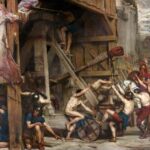Pompeii is one of the most amazing archaeological discoveries in the history of mankind. A well-preserved ancient city, with the remains of people who did not manage to beat the destructive power of Vesuvius in 79 CE. However, what gives us the most information about the life of those times are the preserved artefacts and buildings.
Along with subsequent excavations in ancient Pompeii, archaeologists and authorities gave the buildings characteristic names, so that it was easier to find oneself in them. And so the street crossing the city in the east-west direction and leading to the Forum was called the Street of Abundance, because a sculpture of the goddess of Abundance was found next to it. The Sea Gate is the one facing the coast; and the Herculanean gate is towards the city of Herculaneum.
We will also come across objects that owe their name to discovered artefacts. The House of the Gold Bracelet takes its name from the distinctive jewellery discovered, and the House of the Faun is named after a surviving bronze statue of a satyr.
In Pompeii, we will also find the House of the Silver Wedding, which was excavated in 1893 and named so because of the 25th wedding anniversary of King Humbert of Italy, celebrated this year. Another domus, the so-called House of the Centenary owes its name to the fact that exactly 1800 years after the burial of Pompeii, the building was excavated.
There are also objects that owe their names to the supposed owners of the houses, e.g. House of Vettiuszów or House of Jukundus.
In order to better organize the excavations and mark the buildings in the 19th century, the famous explorer Giuseppe Fiorelli proposed dividing the city into 9 zones (regiones), quarters (separated by streets) and marking subsequent entrances. And in this way a record was obtained, such as for the House of Vettii – VI.XV.1 – which tells us that this building is located in the sixth region, fifteenth quarter, and the first entrance leads to the building.







